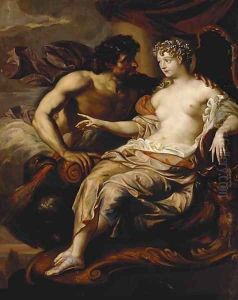Augustus Terwesten Paintings
Augustus Terwesten was a notable Dutch painter and draughtsman, born in The Hague, Netherlands, in 1649. Terwesten's artistic journey began in his early years, showing a profound inclination towards painting and drawing. He initially trained under local artist Willem Doudijns, where he honed his skills in historical painting, a genre that would define much of his career. His talent and dedication to art propelled him to further his studies and refine his techniques, leading him to become one of the prominent figures in the Dutch Golden Age of painting.
Terwesten's work primarily focused on historical and mythological scenes, imbued with a classical elegance and a meticulous attention to detail. His compositions were celebrated for their dynamic figures and vibrant narrative, characteristics that set his work apart from his contemporaries. In 1672, seeking to broaden his horizon and further his study in the arts, Terwesten traveled to Italy, where he was profoundly influenced by the grandeur of Italian Renaissance and Baroque painting. This experience enriched his palette, introduced a greater sense of depth and perspective, and infused his works with a new level of sophistication.
Upon returning to The Hague in the late 1670s, Terwesten established himself as a leading painter and was soon commissioned to work on various prestigious projects, including decorations for the Oranjezaal in Huis ten Bosch Palace. His reputation as a master painter also led him to become a founder and later the head of the Confrerie Pictura, an important guild for painters in The Hague, which played a crucial role in the artistic community by providing a platform for artists to showcase their work and exchange ideas.
In addition to his contributions as an artist, Augustus Terwesten was also a respected teacher, mentoring the next generation of Dutch painters. Among his pupils were his younger brother, Matthias Terwesten, and other notable artists who would go on to leave their mark on Dutch art. Terwesten's legacy is not only reflected in his own works but also in the impact he had on his students and the Dutch artistic community.
Augustus Terwesten passed away in 1711 in The Hague, leaving behind a body of work that continues to be admired for its beauty, technical skill, and historical significance. Today, his paintings can be found in major museums and collections worldwide, serving as a testament to his enduring contribution to the world of art.
